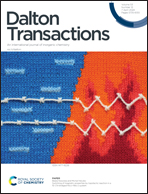Metal- and ligand-substitution-induced changes in the kinetics and thermodynamics of hydrogen activation and hydricity in a dinuclear metal complex†
Abstract
Catalytic function in organometallic complexes is achieved by carefully selecting their central metals and ligands. In this study, the effects of a metal and a ligand on the kinetics and thermodynamics of hydrogen activation, hydricity degree of the hydride complex, and susceptibility to electronic oxidation in bioinspired NiFe complexes, [NiIIX FeII(Cl)(CO)Y]+ ([NiFe(Cl)(CO)]+; X = N,N′-diethyl-3,7-diazanonane-1,9-dithiolato and Y = 1,2-bis(diphenylphosphino)ethane), were investigated. The density functional theory calculations revealed that the following order thermodynamically favored hydrogen activation: [NiFe(CO)]2+ > [NiRu(CO)]2+ > [NiFe(CNMe)]2+ ∼ [PdRu(CO)]2+ ∼ [PdFe(CO)]2+ ≫ [NiFe(NCS)]+. Moreover, the reverse order thermodynamically favored the hydricity degree.



 Please wait while we load your content...
Please wait while we load your content...